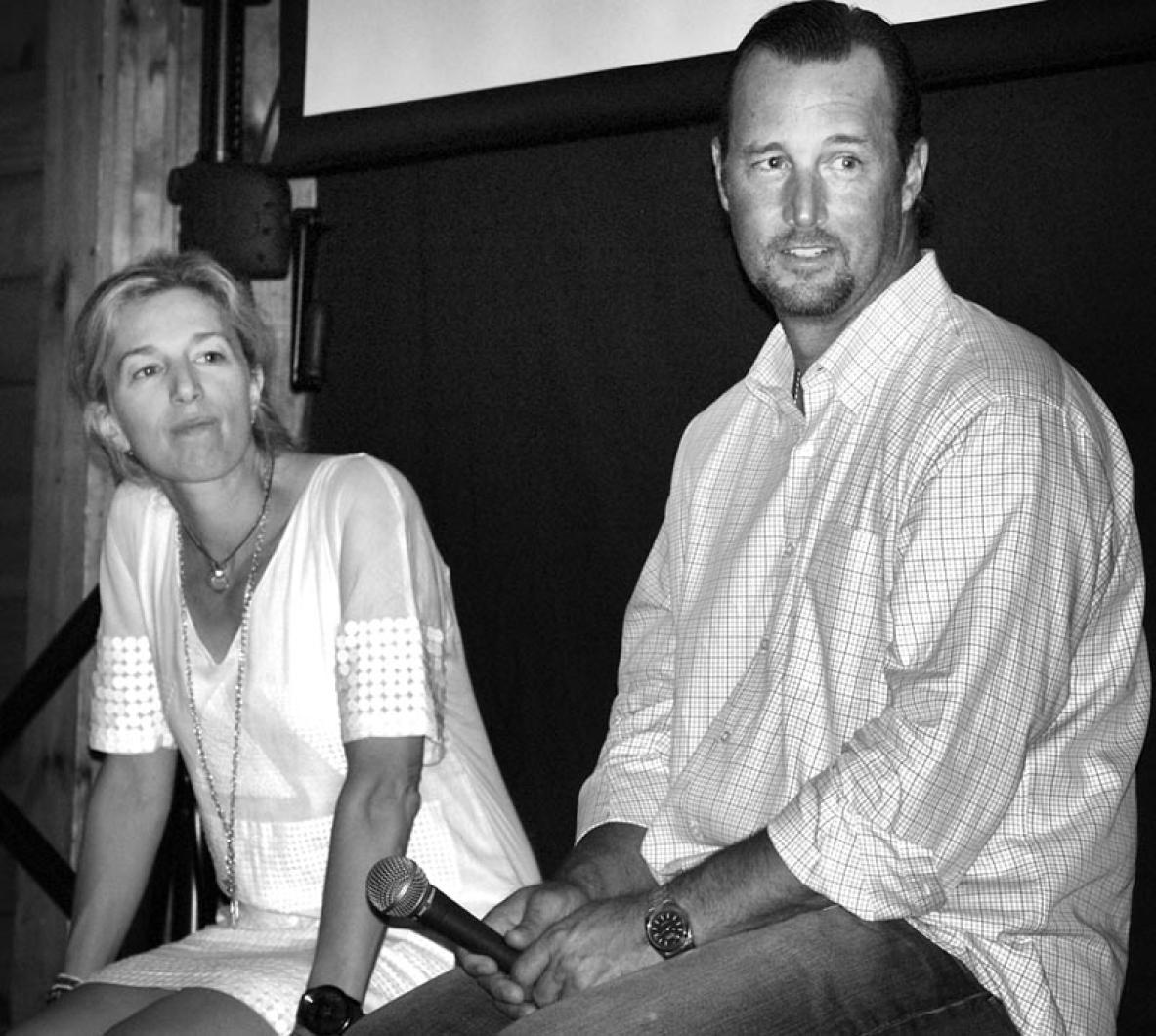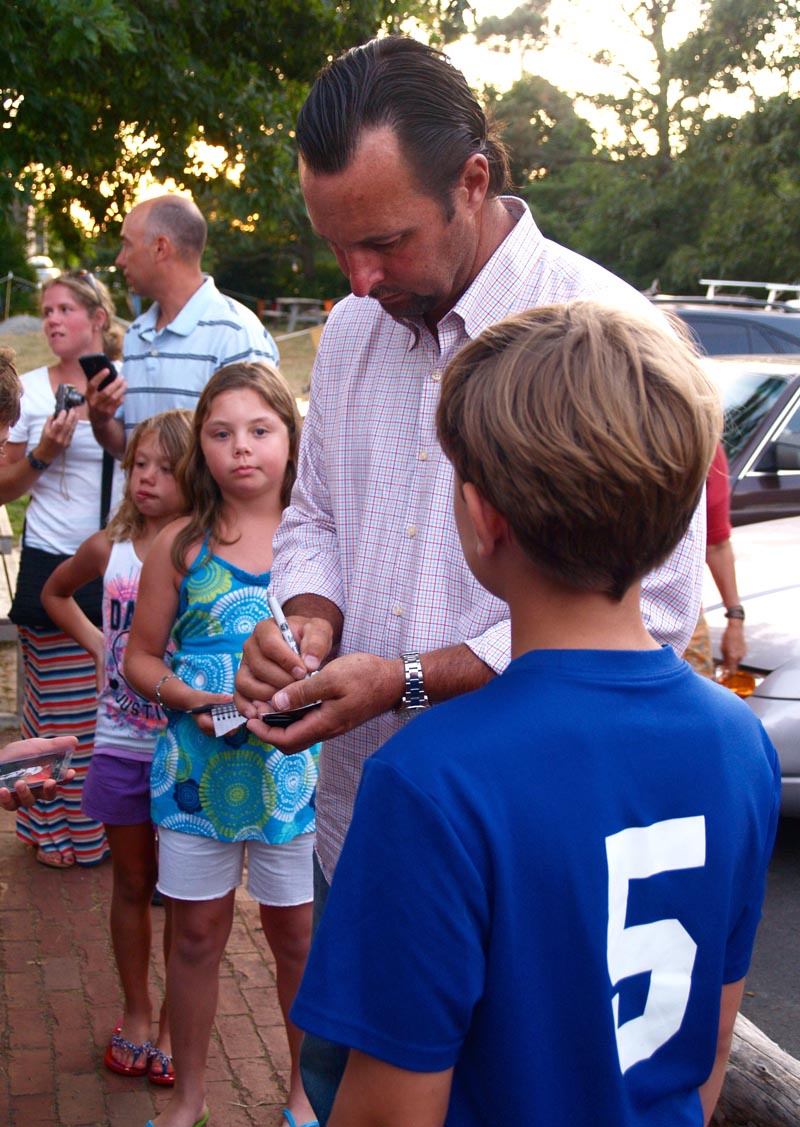Tim Wakefield digs into a baseball just behind the horseshoe of the seams, a grip he credits to longtime Dodgers and Rangers knuckleballer Charlie Hough, one of only a handful of men in the major leagues who have been able to harness the sorcery of the pitch. In February, Mr. Wakefield retired after two decades hurling the strangest pitch in the game, a career that has led him to develop some unlikely skills.
“I actually manicure my nails myself,” he said at a showing last Wednesday of the new documentary Knuckleball! at the Chilmark Community Center, part of the Martha’s Vineyard Film Festival. “I never use anything like nail polish to make them harder. I always made sure I drank lots of milk for protein and I always have a file on me at all times.”
On Thursday Mr. Wakefield, who spent much of the week on the Vineyard, sat down with the Gazette during a second showing of the film — which features him and New York Mets knuckleballer R.A. Dickey — at the Harbor View Hotel in Edgartown.
Every pitch, even the fastball, relies on spin, and the rotation of the seams as they dig into the air. The curveball’s topspin thrusts it down as it approaches the batter, while a good fastball seems to ignore gravity, rising like the heat off a car hood. The knuckleball, however, surrenders. The pitcher counteracts the natural spin of the pitch by flicking it in the opposite direction with his fingertips as he releases. The best knuckleballs have no spin whatsoever and can move in any direction, entirely at the discretion of the air between the mound and the plate. Some batters describe the motion as “spooky.” There is no way players can train themselves to hit one, and even all-star catchers like Jason Varitek struggled for years merely to catch the ball. In fact, Mr. Varitek often took the day off when Mr. Wakefield pitched, as the Red Sox handed the specialized assignment to his backup, primarily Doug Mirabelli,
“It was always a pitch I played around with, but I never took it seriously,” Mr. Wakefield, now 45, recalled of his early years in baseball. “It’s a pitch you can have fun with. It’s a pitch you can hit your friends in the kneecaps with. It’s a pitch that has your own unique personality attached to it.”
For Mr. Wakefield, after a coach happened to notice him throwing the oddball during warmups, it resuscitated a languishing career as a first baseman in the Pittsburgh Pirates farm system and vaulted him to the big leagues. But like the knuckleball itself, Mr. Wakefield’s early career veered unpredictably, from ace of the staff in 1992 to Mr. Irrelevant. He was released by the Pirates in 1995.
“They just felt like it was a freak show that had ended,” he said. “When I got lost in Pittsburgh in 1993, I had nobody to turn to. My pitching coach couldn’t help me, my manager couldn’t help me, nobody could help me except for someone who could throw the knuckleball.”
Fortunately for Mr. Wakefield the Red Sox signed him and sent him to work with the eccentric Niekro brothers, Joe and Phil, both major league knucklers in their own time. The move paid off. Along with Cy Young and Roger Clemens, Mr. Wakefield is one of only three Red Sox pitchers to toss 200 wins. In the 17 years he donned the seriffed B, his workmanlike attitude, durability and humbleness won over Red Sox Nation. But it was his signature, and some would argue, only pitch (his low to mid-70s fastball would be a change-up by most major league standards) that captured the imagination of New England.
But if Sox fans never knew which Tim Wakefield would take the mound each night, neither, by his own admission, did he.
“There were so many times I left the bullpen thinking I was never going to last the inning and I’d go eight,” he said. “There were times where I left the bullpen thinking I was going to throw a no-hitter that night and never made it out of the first [inning]. There also have been times where I got into the second or third inning and I just lost complete feel for the pitch and I just looked at the manager and [said] like, ‘you’ve got to make a move or we’re not going to win’.”
The pitch can be thrown tremendously slowly, a rebuke to the bigger, faster, stronger trend in baseball that has infected both sides of the plate: Cincinnati closer Aroldis Chapman elicited gasps in the Reds stadium last season when the radar after one fastball topped out at an unearthly 106 mph.
“I was never blessed to throw like that but that’s what makes the story so special,” he said. “Anybody, regardless of how hard you can throw, can be successful in the major leagues.”
Now, with Mets phenom Dickey carrying the torch, Mr. Wakefield is hopeful for the future of the knuckleball. Mr. Wakefield is a mentor of sorts to the 37-year-old Dickey—who rescued his own career from the annals of obscurity with the pitch—just as the Niekros and Charlie Hough did before him. At the Chilmark showing, a jesting Mr. Wakefield revealed that Mr. Dickey sees a Korean manicurist to manage his pitching hand.
“I’m really happy for him and proud of him too, because he’s brought a legitimacy to the pitch,” he said. “It’s something I fought my whole life for, to convince people its an authentic pitch. A lot of people still don’t believe it.”
While the eerie pitch made for a career filled with spells of dazzling performances and the occasional gut-punch defeat, what Mr. Wakefield may be most remembered for was his selflessness.
“I would say a time or two in my career I would tell the manager ‘Hey, I don’t have it tonight,” but in order to save the bullpen pitchers from exerting themselves in a losing effort, Mr. Wakefield would remain in the game even though he was getting hit hard by the opposing team. “I’ll go and get my brains beat in for six or seven innings,” he would tell the manager. “I don’t care, I’m not going to be hurt by it. My numbers might be hurt by it but emotionally and physically I won’t be hurt by it, so let me take one for the team.”
Like a pitch for which there is no prescribed path, other than the one the wind has ordained, Mr. Wakefield has cultivated a zen outlook that served him for 20 years in the major leagues.
“I think the biggest lesson I learned through my whole journey is something Phil Niekro told me. Be able to accept your losses without being defeated. I think that’s a huge lesson not only in baseball but also in life. Move on with your life. Whether I lost a game 10-0 or 2-1, I learned to be able to accept a loss but never be defeated. I always say there’s a reason why they make the windshield in a car so big and the rearview mirror so small.”






Comments
Comment policy »